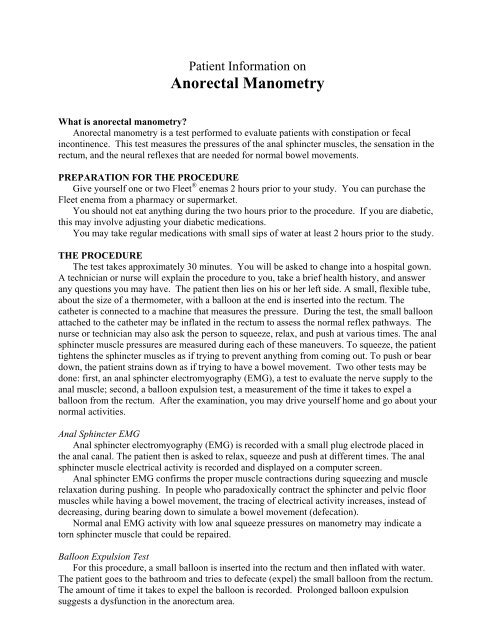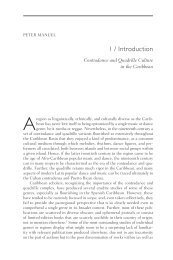Anorectal Manometry - Patient Information
Anorectal Manometry - Patient Information
Anorectal Manometry - Patient Information
You also want an ePaper? Increase the reach of your titles
YUMPU automatically turns print PDFs into web optimized ePapers that Google loves.
<strong>Patient</strong> <strong>Information</strong> on<br />
<strong>Anorectal</strong> <strong>Manometry</strong><br />
What is anorectal manometry?<br />
<strong>Anorectal</strong> manometry is a test performed to evaluate patients with constipation or fecal<br />
incontinence. This test measures the pressures of the anal sphincter muscles, the sensation in the<br />
rectum, and the neural reflexes that are needed for normal bowel movements.<br />
PREPARATION FOR THE PROCEDURE<br />
Give yourself one or two Fleet ® enemas 2 hours prior to your study. You can purchase the<br />
Fleet enema from a pharmacy or supermarket.<br />
You should not eat anything during the two hours prior to the procedure. If you are diabetic,<br />
this may involve adjusting your diabetic medications.<br />
You may take regular medications with small sips of water at least 2 hours prior to the study.<br />
THE PROCEDURE<br />
The test takes approximately 30 minutes. You will be asked to change into a hospital gown.<br />
A technician or nurse will explain the procedure to you, take a brief health history, and answer<br />
any questions you may have. The patient then lies on his or her left side. A small, flexible tube,<br />
about the size of a thermometer, with a balloon at the end is inserted into the rectum. The<br />
catheter is connected to a machine that measures the pressure. During the test, the small balloon<br />
attached to the catheter may be inflated in the rectum to assess the normal reflex pathways. The<br />
nurse or technician may also ask the person to squeeze, relax, and push at various times. The anal<br />
sphincter muscle pressures are measured during each of these maneuvers. To squeeze, the patient<br />
tightens the sphincter muscles as if trying to prevent anything from coming out. To push or bear<br />
down, the patient strains down as if trying to have a bowel movement. Two other tests may be<br />
done: first, an anal sphincter electromyography (EMG), a test to evaluate the nerve supply to the<br />
anal muscle; second, a balloon expulsion test, a measurement of the time it takes to expel a<br />
balloon from the rectum. After the examination, you may drive yourself home and go about your<br />
normal activities.<br />
Anal Sphincter EMG<br />
Anal sphincter electromyography (EMG) is recorded with a small plug electrode placed in<br />
the anal canal. The patient then is asked to relax, squeeze and push at different times. The anal<br />
sphincter muscle electrical activity is recorded and displayed on a computer screen.<br />
Anal sphincter EMG confirms the proper muscle contractions during squeezing and muscle<br />
relaxation during pushing. In people who paradoxically contract the sphincter and pelvic floor<br />
muscles while having a bowel movement, the tracing of electrical activity increases, instead of<br />
decreasing, during bearing down to simulate a bowel movement (defecation).<br />
Normal anal EMG activity with low anal squeeze pressures on manometry may indicate a<br />
torn sphincter muscle that could be repaired.<br />
Balloon Expulsion Test<br />
For this procedure, a small balloon is inserted into the rectum and then inflated with water.<br />
The patient goes to the bathroom and tries to defecate (expel) the small balloon from the rectum.<br />
The amount of time it takes to expel the balloon is recorded. Prolonged balloon expulsion<br />
suggests a dysfunction in the anorectum area.
What can be learned from anorectal manometry?<br />
The anal and rectal area contains specialized muscles that are helpful to regulate proper<br />
passage of bowel movements.<br />
Normally, when stool enters the rectum, the anal sphincter muscle tightens to prevent<br />
passage of stool at an inconvenient time. If this muscle is weak or does not contract in a timely<br />
way, incontinence (leakage of stool) may occur.<br />
Normally, when a person pushes or bears down to have a bowel movement, the anal<br />
sphincter muscles relax. This will cause the pressures to decrease allowing evacuation of stool. If<br />
the sphincter muscles tighten when pushing, this could contribute to constipation.<br />
Anal manometry measures how strong the sphincter muscles are and whether they relax as<br />
they should during passing a stool. It provides helpful information to the doctor in treating<br />
patients with fecal incontinence or severe constipation.<br />
There are many causes of fecal incontinence. Weak anal sphincter muscles or poor sensation<br />
in the rectum can contribute to fecal incontinence. If these abnormalities are present, they can be<br />
treated. Biofeedback techniques using anal manometry and special exercises of the pelvic floor<br />
muscles can strengthen the muscles and improve sensation. This can help treat fecal<br />
incontinence.<br />
There are many causes of constipation. Some involve sluggish movement through the whole<br />
colon, whereas others involve the anal sphincter muscles. In some patients with constipation, the<br />
anal sphincter muscles do not relax appropriately when bearing down or pushing to have a bowel<br />
movement. This abnormal muscle function may cause a functional type of obstruction. Muscles<br />
that do not relax with bearing down can be retrained with biofeedback techniques using anal<br />
manometry.<br />
Risks of <strong>Anorectal</strong> <strong>Manometry</strong><br />
<strong>Anorectal</strong> manometry is a safe, low risk procedure and is unlikely to cause any pain.<br />
Complications are rare: it is possible that a perforation (tearing) or bleeding of the rectum could<br />
occur. Equipment failure is a remote possibility. If you are allergic to latex, you should inform<br />
the nurse/technician before the test so that a latex free balloon can be used.<br />
5/4/2008
















